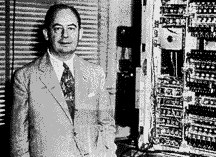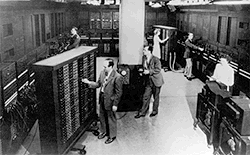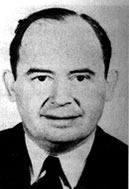click on the home button to go to the thocp home page
|
The Pre Industrial Era 1944-1946 Von Neumann creates the stored program principle, a revolutionary design that will push technology forward. |
pre history | antiquity
| pre industrial era | industrial
era
1886 -
1900 - 1927
- 1938 - 1940 - 1944
| Related Articles |
| Related Resources |
|
|
![]() Howard Aiken,
at the Harvard university (USA) together with engineers of IBM start to operate
the Harvard MARK-I computer, the "Automated Sequence Controlled
Calculator". It is the first American computer that can be programmed via
a ordinary punch tape in stead of rewiring the machine for each new assignment.
It is a relay-based machine.
Howard Aiken,
at the Harvard university (USA) together with engineers of IBM start to operate
the Harvard MARK-I computer, the "Automated Sequence Controlled
Calculator". It is the first American computer that can be programmed via
a ordinary punch tape in stead of rewiring the machine for each new assignment.
It is a relay-based machine.

Grace Murray Hopper starts her career by programming this machine.
 (9)
(9)![]() John
Von Neumann responded with a complete logical design for a machine to be called
the EDVAC (Electronic Discrete Variable Automatic Computer). In his paper
was embedded the idea of a "stored program." He suggests that instructions
for the computer -- previously entered on punched paper tape, or by plugboards
-- can be stored in the computer's electronic memory as numbers and treated
exactly the same as numerical data.
John
Von Neumann responded with a complete logical design for a machine to be called
the EDVAC (Electronic Discrete Variable Automatic Computer). In his paper
was embedded the idea of a "stored program." He suggests that instructions
for the computer -- previously entered on punched paper tape, or by plugboards
-- can be stored in the computer's electronic memory as numbers and treated
exactly the same as numerical data.
For the first time the logical choices of program sequences can be made inside
the machine, and instructions can be modified by the computer as it goes along.
![]() In this year (1945), three major
lines of development -- logical automata, statistical machines, and calculating
machines have come together to form the electronic computer.
In this year (1945), three major
lines of development -- logical automata, statistical machines, and calculating
machines have come together to form the electronic computer.
![]() John Presper Eckert, John
William Maunchly, Herman Goldstine (USA) and A. Turing are
continuing their research in the field of electronic data processing. Their
product is the ENIAC (Electronic Numerical Integrator and Computor(4)).
One of the first full electronic computers designed as a general purpose machine.
De ENIAC is about a 1000 times faster then the Mark-I
John Presper Eckert, John
William Maunchly, Herman Goldstine (USA) and A. Turing are
continuing their research in the field of electronic data processing. Their
product is the ENIAC (Electronic Numerical Integrator and Computor(4)).
One of the first full electronic computers designed as a general purpose machine.
De ENIAC is about a 1000 times faster then the Mark-I

ENIAC 12
The ENIAC will be set in operation in 1946 at the University of Pennsylvania. It measures 1 x 2.1 x 33 meters, 140 square meter, contains 18.000 vacuum tubes, 1500 relays, and uses 180 kWh, its volume was 100 m3 and weighed appr. 30.000 kilo. A real big one that consumed the energy of a small village in one single hour.
Programming was done by plugging cables and setting switches. Data was entered
by punched cards.
Programming for typical calculations took from half a hour to a day.
The ENIAC is superfast for this period of time. A human calculator would need
100 years to do what the ENIAC did in just two hours. The machine calculates
2000 times faster then a machine build from relays. Truly amazing. The programming
however is still done by setting switches and rewiring of circuit boards.
The ENIAC is still a decimal system and does not contain enough memory to contain
complex programs in its memory.
The machine will primarily be used to calculate ballistic trajectories for the
USA ARMY.
Eckert and Mauchly underestimated what was needed to commercialize a computer
and had to sell their company to Remington-Rand in 1950.(14)
![]() An American GI with an electric
adding machine and a Japanese accountant with an abacus had a competition. The
Abacus was faster in all except multiplication.
An American GI with an electric
adding machine and a Japanese accountant with an abacus had a competition. The
Abacus was faster in all except multiplication.
![]() During the Mark-II programming
project a maintenance engineer defines a "Bug" in a maintenance
log. It is this little creature that got stuck in the engine and prevents it
from working correctly. This bug got his immortality with its death.
During the Mark-II programming
project a maintenance engineer defines a "Bug" in a maintenance
log. It is this little creature that got stuck in the engine and prevents it
from working correctly. This bug got his immortality with its death.

original bug found by maintenance
A bug is an error in a program that causes the program to malfunction.
![]()
 30
June, John von Neumann writes "First Draft of a Report on the EDVAC"
in which he outlined the architecture of a stored-program computer. Von Neumann
has the following brilliant idea:
30
June, John von Neumann writes "First Draft of a Report on the EDVAC"
in which he outlined the architecture of a stored-program computer. Von Neumann
has the following brilliant idea:
The next step of a program should depend on the previous one
This principle - stored program - will determine the architecture of the computer generations to follow.
Goldstine, the project manager, distributed the memo, put von Neumann’s
name on it and omitted Eckert’s and Mauchly’s names.(15)
Most computer historians agree that von Neumann received far more credit than
he deserved.(16)
This architecture will be called the Van Neumann Architecture. Von Neumann based
his idea on that of his predecessors: Turing, Mauchly and Eckert.
Electronic storage of programming information and data eliminated the need for
the more clumsy methods of programming, such as punched paper tape -- a concept
that has characterized mainstream computer development since 1945.
![]() The
Bell Labs Computer Modell IV is completed. (1)
The
Bell Labs Computer Modell IV is completed. (1)
![]() Konrad
Zuse describes Plankalkuel, the first higher-level programming language.
Konrad
Zuse describes Plankalkuel, the first higher-level programming language.
![]() Konrad Zuse constructs
a programmable machine: the Z22.
Konrad Zuse constructs
a programmable machine: the Z22.
This machine can not only process numbers but also words. One of its first assignments
is to make a poem of 2 million lines. The program contains a number of instructions
and some data 16 nouns and 60 adjectives etc.) But after 500 meters of paper
the program is killed, experiment successful. The nameless and unfinished poem
is given in parts to some persons unaware that is has been created by a machine.
Most of them found the poem not bad
![]() IBM introduces the IBM 603
Calculator. The first one with vacuum tubes that is produced in series.
This is the end of electro mechanical data processing. Soon a more powerful
type (the 604 finished in 1948) will come out of the production facilities and
5600 will be sold. Unbelievable numbers for this time. Especially if you realize
that there were CEO's and top politicians trying to fool the people by saying
that no more than a few computers would never be needed in the entire world.
IBM introduces the IBM 603
Calculator. The first one with vacuum tubes that is produced in series.
This is the end of electro mechanical data processing. Soon a more powerful
type (the 604 finished in 1948) will come out of the production facilities and
5600 will be sold. Unbelievable numbers for this time. Especially if you realize
that there were CEO's and top politicians trying to fool the people by saying
that no more than a few computers would never be needed in the entire world.
![]() A patent dispute with the Univ.
Pennsylvania drove John Presper Eckert and John Mauchley to move out on their
own and started a business partnership - Electronic Control Co. - that will
become the Eckert-Mauchly Computer Corporation. Their first address is 1215
Walnut St. In Philadelphia. This firm will be one of the fearsest competitors
to IBM in the mainframe sector.
A patent dispute with the Univ.
Pennsylvania drove John Presper Eckert and John Mauchley to move out on their
own and started a business partnership - Electronic Control Co. - that will
become the Eckert-Mauchly Computer Corporation. Their first address is 1215
Walnut St. In Philadelphia. This firm will be one of the fearsest competitors
to IBM in the mainframe sector.
The Electronic Control or Eckert-Mauchly computer is developed and by 1952 it
was being sold as the Univac with a clock rate of 2.25 megahertz.
![]() John Tukey
first coins the term bit for binary digit, the basic unit of data for
computers
John Tukey
first coins the term bit for binary digit, the basic unit of data for
computers
![]() Masaru Ibuka
and Akio Morita set up Sony in Tokio, Kapan
Masaru Ibuka
and Akio Morita set up Sony in Tokio, Kapan
![]()
| Last Updated on February 27, 2004 | For suggestions please mail the editors |
Footnotes & References